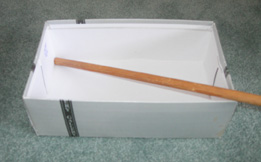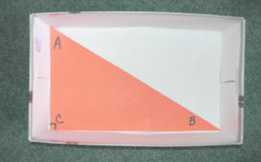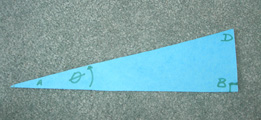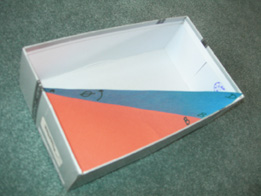Lesson 5
1. Lesson 5
1.4. Discover
Module 4: The Right Kind Of Triangles
Discover

In this activity you will apply right-angle trigonometry to a problem in three dimensions. You will determine the angle a rod makes with the bottom of an open box. You need the following materials to complete this activity:
- small open box (a shoe box is ideal)
- ruler
- protractor
- thin rod that is too long to fit in the box
- stiff paper or cardstock (old file folders work well)
- scissors
- marker
- calculator
Step 1: Place one end of the rod in one corner of the box as shown in the picture. Measure the length of the rod found inside the box and remove it from the box. Also measure and record the inside dimensions (length, width, and height) of the box. Create a chart to organize your measurements.
Length of rod:
Length of box:
Width of box:
Height of box:

Step 2: Cut out and label a right triangle that will lie flat on the bottom of the box, as shown in the photograph. The legs of the triangle are the same as the width and length of the inside of the box. The hypotenuse of the triangle lies along the diagonal at the bottom of the box. Think of a way to determine the length of the hypotenuse of ![]() .
.
Step 3: Cut out and label a second triangle (ABD) so that the base of the new triangle is the same length as the hypotenuse (AB) of ![]() . The height of
. The height of ![]() must match the height of the inside of the box. Fit
must match the height of the inside of the box. Fit ![]() vertically along the diagonal, as shown in the photograph. Think of a way to determine the length of the hypotenuse of
vertically along the diagonal, as shown in the photograph. Think of a way to determine the length of the hypotenuse of ![]() .
.


Step 4: To determine the measure of ∠θ (the angle the rod makes with bottom of the box) answer the following questions.
Try This 1
- Without using a ruler, determine the length of AB, the hypotenuse of
 .
.  is the triangle lying flat on the bottom of the box.
is the triangle lying flat on the bottom of the box.
- You now know the lengths of two of the sides of
 . Which sides are they? What are their lengths?
. Which sides are they? What are their lengths?
- Use trigonometry to determine the measure of ∠θ. Use your protractor to check your answer. Are they the same?
![]() Save a copy of your responses in your course folder.
Save a copy of your responses in your course folder.
Share 1
Share your responses to the questions in Try This 1 with a classmate or in a group.
How do the calculations you used in each step compare with others? Would you change any of the strategies or calculations you used?